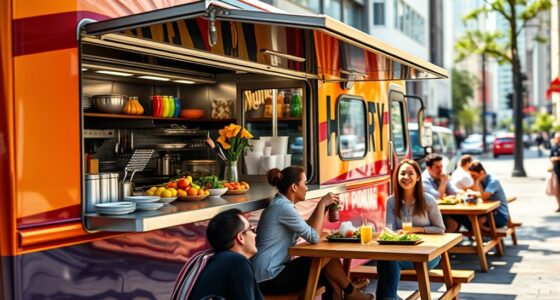To effectively conduct market research for your food truck, start by engaging with your potential customers through surveys, social media, and casual conversations to understand their preferences and habits. Visit local competitors to assess their menus, pricing, and customer flow, then identify gaps you can fill. Determine your target demographic and choose locations with high foot traffic. By analyzing these insights, you can tailor your offerings, pricing, and marketing strategies to stand out—keep exploring to learn more about refining your approach.
Key Takeaways
- Engage with potential customers through surveys and social media to understand their preferences and expectations.
- Visit competitors to analyze their menus, pricing, and customer flow for market gap identification.
- Identify target demographics and tailor your menu offerings to meet their specific tastes and needs.
- Research high foot-traffic locations and local events to select optimal setup spots for your food truck.
- Use market data to set competitive prices and develop marketing strategies that resonate with your audience.

Are you considering launching a food truck? If so, conducting thorough market research is essential to set yourself up for success. One of the first areas to focus on is understanding your potential customers. Customer engagement plays a pivotal role here; you need to know what your audience values, their eating habits, and what drives their food choices. By engaging with your community through surveys, social media, or informal conversations, you can gather insights into their preferences and expectations. This understanding helps you tailor your offerings to meet demand and build a loyal customer base from day one.
Understanding your target customers is key to food truck success through community engagement and market insights.
Equally important is evaluating your competition. Visit existing food trucks and local eateries to observe what they do well and where they fall short. Notice their menu offerings, pricing, and customer flow. This research helps identify gaps in the market and opportunities for differentiation. For example, if most trucks serve burgers and fries, introducing a unique cuisine or healthier options might attract a broader audience. When considering menu innovation, think about what can set your truck apart. Incorporate fresh ideas, seasonal ingredients, or specialty items that excite customers and encourage repeat visits.
Knowing your target demographic is essential. Are you aiming at busy professionals, students, families, or tourists? Each group has distinct preferences, and your menu should reflect their tastes. For instance, quick, affordable, and portable options appeal to professionals on lunch breaks, while larger, shareable dishes might attract families or groups. Conducting local market research helps you understand the demographics and their dining habits, enabling you to craft a menu that resonates with them.
Location is another key factor. Research the areas with high foot traffic, events, or markets where you can set up shop. Understanding the local environment allows you to adapt your menu and marketing strategies accordingly. For example, if you’re near a college campus, offering trendy, Instagram-worthy dishes can boost customer engagement. If you’re near a business district, focus on quick, satisfying meals that cater to busy workers.
Finally, don’t forget to analyze pricing strategies. Market research helps you determine what customers are willing to pay and how to price your menu competitively. Keeping your prices aligned with customer expectations while maintaining healthy profit margins is a balancing act that requires careful research. Additionally, staying informed about cryptocurrency pump trends can provide insights into emerging marketing opportunities, especially if you plan to accept digital currencies or promote special offers through online channels. When you combine customer insights, menu innovation, and a clear understanding of the local market, you’ll position your food truck for sustained success.
Frequently Asked Questions
How Do I Identify My Target Customer Demographic?
You identify your target customer demographic by analyzing customer preferences and conducting location analysis. Consider what types of food your potential customers enjoy and their age, lifestyle, and income levels. Visit busy areas and observe who stops for food. Use surveys or social media polls to gather insights. Combining these methods helps you pinpoint who your ideal customers are, allowing you to tailor your menu and marketing efforts effectively.
What Are the Best Tools for Conducting Market Surveys?
You should use survey platforms like SurveyMonkey or Google Forms to gather customer insights quickly and easily. These tools allow you to create customized surveys and reach your target audience efficiently. Pair them with data analysis tools like Excel or Google Sheets to interpret responses effectively. This combination helps you identify customer preferences, improve your food truck offerings, and tailor your marketing strategies to attract your ideal demographic.
How Do Seasonal Trends Affect Food Truck Market Research?
Imagine planning your menu around summer festivals; seasonal trends greatly influence your market research. You should focus on seasonal menu planning and weather impact analysis to understand fluctuations in customer demand. For example, if a harsh winter hits, you might see decreased foot traffic, prompting you to adapt your offerings or locations. Tracking these trends helps you optimize operations and boost sales year-round by staying ahead of seasonal shifts.
How Can I Analyze Competitors’ Strengths and Weaknesses?
You can analyze competitors’ strengths and weaknesses through a competitive analysis by observing their menu offerings, pricing, customer reviews, and location. Conduct a SWOT assessment to identify their strengths, such as popular dishes or strong branding, and weaknesses like limited menu options or poor customer service. Visit their trucks, gather feedback, and compare these insights with your own to find opportunities for differentiation and improvement.
What Legal Considerations Should I Be Aware of During Research?
You need to guarantee legal compliance during your research by understanding local regulations and restrictions. Obtain all necessary permits and licenses before gathering data or testing products, so you’re not violating any laws. Check health department requirements, zoning laws, and business licenses specific to food trucks. Staying compliant protects you from fines or shutdowns and helps you build a legitimate, trustworthy operation from the start.
Conclusion
Knowing your target market is key—you’ll find that over 60% of successful food trucks identify a specific niche. This focus helps attract loyal customers and stand out in a crowded scene. By conducting thorough market research, you gain valuable insights that guide your menu, location, and marketing strategies. Remember, understanding your audience isn’t just helpful; it’s essential for turning your food truck dreams into a thriving reality.









